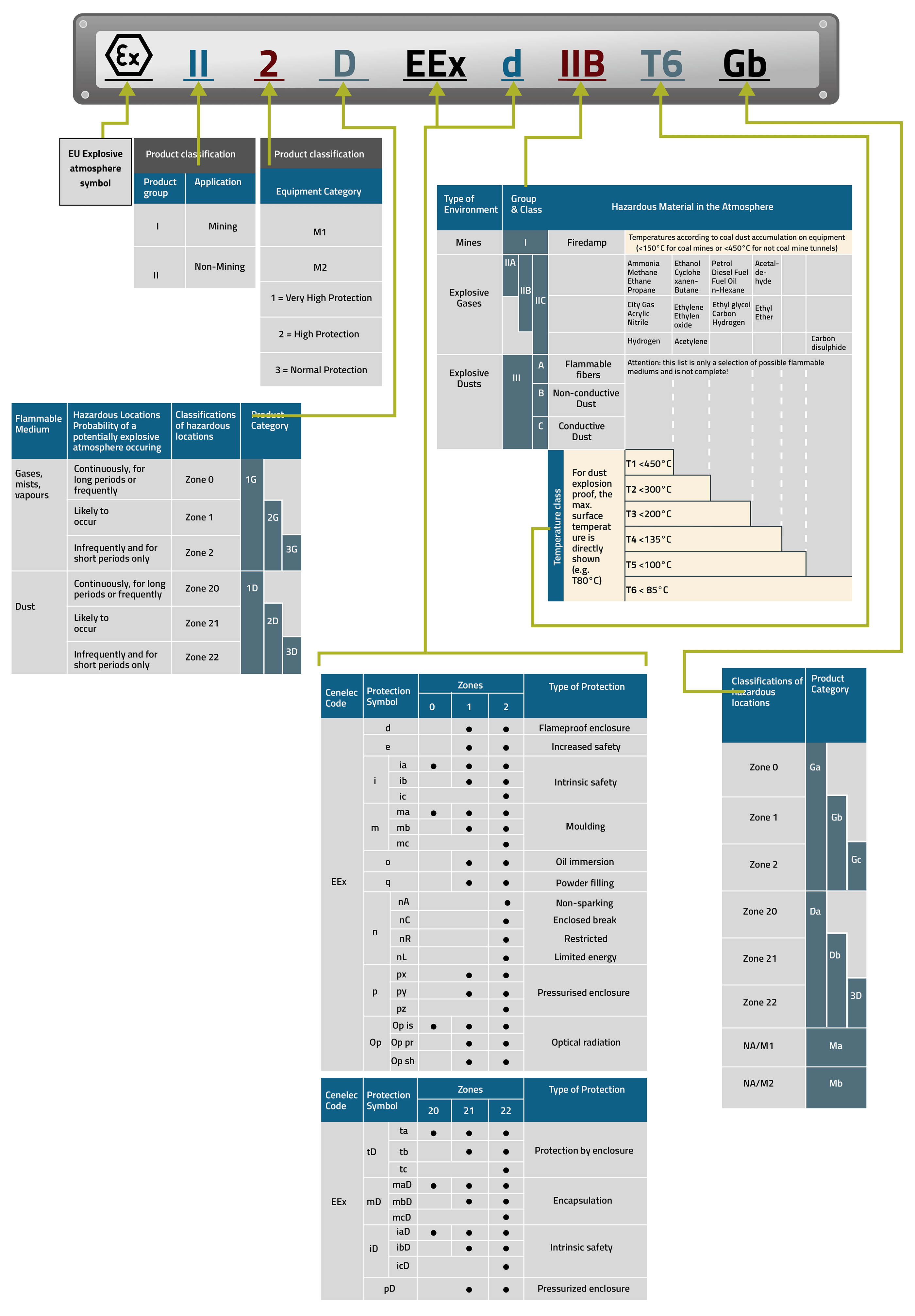NFPA 70 EC Labelling of Explosion Proof Equipment
Please use the graph below to evaluate your explosion proof needs.
| NFPA 70 NEC Hazardous Locations Classes, Divisions and Groups | ||
| Class | Division | Group |
| Class I – Flammable gases or vapors may be present |
Division 1: Ignitable concentrations of hazards exist under normal operation conditions and/or where the hazard is caused by frequent maintenance or repair work or frequent equipment failure.
Division 2: Ignitable concentrations of hazards exist under abnormal operation conditions. |
Group A: Acetylene
Group B: Hydrogen, butadiene, ethylene oxide, propylene oxide, and acrolein Group C: Ethylene, cyclopropane, and ethyl ether Group D: Acetone, ammonia, benzene, butane, ethanol, gasoline, hexane, methane, methanol, naphtha, natural gas, propane, and toluene |
| Class II – Combustible dust may be present | Division 1: Ignitable concentrations of hazards exist under normal operation conditions and/or where the hazard is caused by frequent maintenance or repair work or frequent equipment failure.
Division 2: Ignitable concentrations of hazards exist under abnormal operation conditions. | Group E: Combustible metal dusts: aluminum, commercial alloys, and magnesium
Group F: Combustible carbonaceous dusts: carbon black, charcoal, coal, and coke dusts Group G: Other combustible dusts: chemicals, flour, grain, plastic, and wood |
| Class III – Easily ignitable fibers or flyings may be present | Division 1: Ignitable concentrations of hazards exist under normal operation conditions and/or where the hazard is caused by frequent maintenance or repair work or frequent equipment failure.
Division 2: Ignitable concentrations of hazards exist under abnormal operation conditions. | Group: Not Applicable |
| NFPA 70 NEC Hazardous Locations Zones | |
| Gases, Vapors, and Mists | Zone 0: Ignitable concentrations of flammable gases or vapors which are present continuously or for long periods of time. |
| Zone 1: Ignitable concentrations of flammable gases or vapors which are likely to occur under normal operating conditions; may exist frequently because of repair/maintenance operations or leakage; or equipment is operated in a manner that equipment breakdown/faulty operations could result in the release of ignitable concentrations of flammable gases or vapors and failure of the equipment. | |
| Zone 2: Ignitable concentrations of flammable gases or vapors which are not likely to occur under normal operating conditions and if they do will only persist for a short period of time; or volatile flammable liquids, gases, or vapors are confined within closed containers/systems and can escape only as a result of an accidental rupture; or volatile flammable liquids, gases, or vapors are normally prevented by positive mechanical ventilation, but may become hazardous due to system failure. Easily Ignitable Fibers or Flyings | |
| Gases, Vapors, and Mists | Zone 20: Combustible dusts or ignitable fibers/flyings are present continuously or for long periods of time. |
| Zone 21: Combustible dusts or ignitable fibers/flyings are likely to occur under normal operating conditions; or may exist frequently because of repair/maintenance operations or leakage; or equipment is operated in a manner that breakdown/faulty operations could result in the release of ignitable concentrations of combustible dust or fibers/flyings and failure of the equipment. | |
| Zone 22: Combustible dusts or ignitable fibers/flyings are likely to occur under normal operating conditions; or may exist frequently because of repair/maintenance operations or leakage; or equipment is operated in a manner that breakdown/faulty operations could result in the release of ignitable concentrations of combustible dust or fibers/flyings and failure of the equipment. | |
| NFPA 70 NEC Hazardous Locations Groups | ||
| Group I
Mines susceptible to firedamp (flammable mixture of gases naturally occurring in a mine) | Group II | Group III |
| Explosive dusts - Group III equipment is subdivided into three subgroups | ||
| A - Atmospheres containing acetone, ammonia, ethyl alcohol, gasoline, methane, propane, or gases/vapors of equivalent hazard | A - Atmospheres containing solid particles and fibers greater than 500 microns that could be suspended in air and settle out | |
| B- Atmospheres containing acetaldehyde, ethylene, or gases / vapors of equivalent hazard | B - Atmospheres containing combustible dusts other than combustible metal dusts | |
| C - Atmospheres containing acetylene, hydrogen, or gases/vapors of equivalent hazard | C - Atmospheres containing combustible metal dusts | |
ATEX Labelling of Explosion Proof Equipment
Please use the graph below to evaluate your explosion proof needs. Or download the graph.



